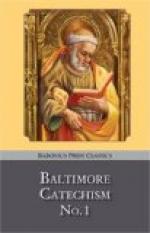Next in order in the life of Our Lord come the five events called the Sorrowful Mysteries, namely: (1) The agony in the garden, when Our Lord went there to pray on Holy Thursday night, before He was taken prisoner. There the blood came out through His body as perspiration does through ours, and He was in dreadful anguish. The reason of His sorrow and anguish has already been given in the explanation of the Passion. (2) The scourging of Our Lord at the pillar. This also has been explained. What terrible cruelty existed in the world before Christianity! In our times the brute beasts have more protection from cruel treatment than the pagan slaves had then. The Church came to their assistance. It taught that all men are God’s children, that slaves as well as masters were redeemed by Jesus Christ, and that masters must be kind and just to their slaves. Many converts from paganism through love for Our Lord and this teaching of the Church, granted liberty to their slaves; and thus as civilization spread with the teaching of Christianity, slavery ceased to exist. It was not in the power of the Church, however, to abolish slavery everywhere, but she did it as soon as she could. Even at present she is fighting hard to protect the poor Negroes of Africa against it, or at least to moderate its cruelty. (3) The third Sorrowful Mystery is the crowning with thorns. (4) The carriage of the Cross to Calvary. It was the common practice to make the prisoner at times carry his cross to the place of execution, and over the cross they printed what he was put to death for. That is the reason they placed over Our Lord’s cross I.N.R.I., which are the first letters of four Latin words meaning, “Jesus of Nazareth, King of the Jews.” They pretended by this sign that Our Lord was put to death for calling Himself King of the Jews, and was thus a disturber of the public peace, and an enemy of the Roman emperor under whose power they were. Our Lord did say that He was King of the Jews, but He also said that He was not their earthly but their heavenly king. The real cause of their putting Our Lord to death was the jealousy of the Jewish priests and Pharisees. He rebuked them for their faults, and showed the good, sincere people what hypocrites these men were. (5) The last of the Sorrowful Mysteries is the Crucifixion. At the foot of the Cross our blessed Mother stood on the day of Crucifixion, and it must have been a very sad sight for Our Lord. She was without anyone to take care of her; for St. Joseph was dead, and her Son was soon to die. Our Lord asked St. John, one of His Apostles, to take care of her. St. John was dear to Christ, and on that account is called the beloved disciple. He is known to us as St. John the Evangelist. He was the last of the Apostles to die. At one time he was cast into a cauldron of boiling oil, but was miraculously saved by God (see Butler’s Lives of the Saints, Dec. 27). He lived to be over a hundred years old, and while




